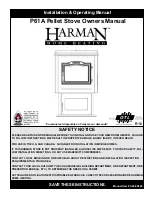
PAGE 13
3.0 OPERATING INSTRUCTIONS
3.1 - General Information
All national, regional, local laws, orders and regulations must be kept.
Therefore, depending on the location of installation, special operating conditions and restrictions can be
enforced regarding the period of use and fuels used. It is important to consult a chimney sweep or other
competent expert before installing and using the appliance.
3.2 - Suitable Fuels
The fuel recommended for use is Dry wood/logs(Beech, oak etc..). You can find the exact information on the
technical data sheet and the type board. You can only use these specific fuels. Usage of other fuels is not
allowed.
Depending on your choice of the fuels listed above, be sure that you use fuels of good quality. Wooden logs
reach 15-20% humidity which is the most appropriate for heating if they are stored outside for 1-2 years
(if they are covered and protected from rain). Recently cut wood has a high moisture content and burns
poorly and causes soot. Apart from its very low heating value it is also a pollutant to the environment. High
condensation and tar can lead to blockage in the stove and especially in the chimney. In all cases it causes
deposit on the glass front and emissions that need to be avoided.
Burning wood is recommended for operating the stove at its nominal capacity. Watch the heating value of
the fuel you use. You can get the exact data at a fuel supplier. Load the fireplace with fuel according to heat
demand. The heating value of 1kg of dry wood is 4-4.5kW. This means you can place about 2.4kg of wood into
a stove of 8kW capacity every hour.
When burning wood, if a lower capacity is required, do not restrain the fire. Put less wood in at one time
instead. Don’t throw the fuel in the combustion chamber, because it can damage or break the chamotte or
vermiculite tiles. Be aware that the volume of some types of fuel increases during burning.
The types of fuels that can be used, the maximum quantities that can be loaded at one time and the description
of settings for the air regulators, can be found in the technical chart.
3.3 - Reducing Emissions
You can only avoid unwanted emissions by the use of the specified fuels. Put only the amount of fuel in the
fireplace that is appropriate for necessary heat transmission. Burning more fuel is unnecessary and leads
to unwanted emissions. Don’t burn waste in your stove. The use of other fuels than the ones listed is not
allowed. You MUST NOT burn the following materials in your stove:
• Wet or treated wood
• Wood-shavings/sawdust
• Inner bark, bark, shavings panel
• Coal dust
• Waste, scrap, plastic, rubble
• Paper and cardboard (apart from use as firestarter)
Содержание Virgo
Страница 2: ......
Страница 18: ...PAGE 18 APPENDIX 1 DIMENSIONAL DRAWINGS 125 125 1180 470 470 ...
Страница 19: ......






































